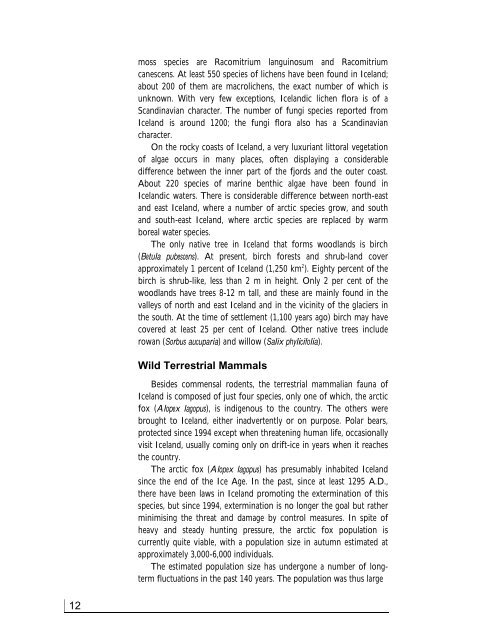BIOLOGICAL DIVERSITY IN ICELAND - Convention on Biological ...
BIOLOGICAL DIVERSITY IN ICELAND - Convention on Biological ...
BIOLOGICAL DIVERSITY IN ICELAND - Convention on Biological ...
- No tags were found...
You also want an ePaper? Increase the reach of your titles
YUMPU automatically turns print PDFs into web optimized ePapers that Google loves.
moss species are Racomitrium languinosum and Racomitriumcanescens. At least 550 species of lichens have been found in Iceland;about 200 of them are macrolichens, the exact number of which isunknown. With very few excepti<strong>on</strong>s, Icelandic lichen flora is of aScandinavian character. The number of fungi species reported fromIceland is around 1200; the fungi flora also has a Scandinaviancharacter.On the rocky coasts of Iceland, a very luxuriant littoral vegetati<strong>on</strong>of algae occurs in many places, often displaying a c<strong>on</strong>siderabledifference between the inner part of the fjords and the outer coast.About 220 species of marine benthic algae have been found inIcelandic waters. There is c<strong>on</strong>siderable difference between north-eastand east Iceland, where a number of arctic species grow, and southand south-east Iceland, where arctic species are replaced by warmboreal water species.The <strong>on</strong>ly native tree in Iceland that forms woodlands is birch(Betula pubescens). At present, birch forests and shrub-land coverapproximately 1 percent of Iceland (1,250 km 2 ). Eighty percent of thebirch is shrub-like, less than 2 m in height. Only 2 per cent of thewoodlands have trees 8-12 m tall, and these are mainly found in thevalleys of north and east Iceland and in the vicinity of the glaciers inthe south. At the time of settlement (1,100 years ago) birch may havecovered at least 25 per cent of Iceland. Other native trees includerowan (Sorbus aucuparia) and willow (Salix phylicifolia).Wild Terrestrial MammalsBesides commensal rodents, the terrestrial mammalian fauna ofIceland is composed of just four species, <strong>on</strong>ly <strong>on</strong>e of which, the arcticfox (Alopex lagopus), is indigenous to the country. The others werebrought to Iceland, either inadvertently or <strong>on</strong> purpose. Polar bears,protected since 1994 except when threatening human life, occasi<strong>on</strong>allyvisit Iceland, usually coming <strong>on</strong>ly <strong>on</strong> drift-ice in years when it reachesthe country.The arctic fox (Alopex lagopus) has presumably inhabited Icelandsince the end of the Ice Age. In the past, since at least 1295 A.D.,there have been laws in Iceland promoting the exterminati<strong>on</strong> of thisspecies, but since 1994, exterminati<strong>on</strong> is no l<strong>on</strong>ger the goal but ratherminimising the threat and damage by c<strong>on</strong>trol measures. In spite ofheavy and steady hunting pressure, the arctic fox populati<strong>on</strong> iscurrently quite viable, with a populati<strong>on</strong> size in autumn estimated atapproximately 3,000-6,000 individuals.The estimated populati<strong>on</strong> size has underg<strong>on</strong>e a number of l<strong>on</strong>gtermfluctuati<strong>on</strong>s in the past 140 years. The populati<strong>on</strong> was thus large12
















